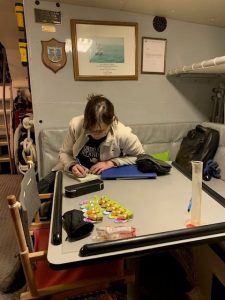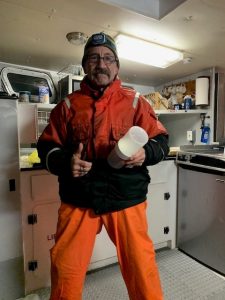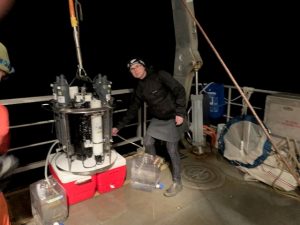Adventures in the Gulf of Maine – Part 1
This is the first of two (or more?) posts about our field campaign in the Gulf of Maine during Spring/Summer 2023.
It started with a simple idea. Becky (Rebecca Gast) suggested that we might work together to study the extent to which feeding on mixotrophic plankton supports the growth and reproduction of copepods. For me, developing this project idea with Becky was a lifeline during the early stages of the COVID19 pandemic. It felt good to collaborate with another living person, even if it was over zoom and email. We planned a series of carefully structured lab experiments to assess the nutritional quality of mixotrophs to copepods. Then we thought it would be “fun” to make some measurements in the field. Nothing too crazy, just a few samples. The project was funded by the National Science Foundation, and I was very excited to get started!
We decided to collect samples from the nearby Gulf of Maine that would allow us to assess the prevalence of mixotrophy in the field, the extent to which copepods were feeding on potential mixotrophs, and the reproductive condition of two copepod species. We selected the Wilkinson Basin Time Series station as a primary sampling site, so we could put our work in context with a larger set of measurements. To round out our sampling plan, we decided to collect samples at three times spanning the spring bloom through mid-summer from a total of three stations. Easy peasy.
Our first cruise started on April 4. Because the copepods we were studying exhibit diel vertical migration and daily variation in feeding activity, I insisted that all of our sampling take place at night (how hard could it be, right?). So, around mid-day Phil Alatalo, Becky and I headed up to Portsmouth, New Hampshire to meet up with the R/V Gulf Challenger. It was around 50°F with sunny skies and (thankfully) calm seas. We loaded our gear, received a safety briefing from Captain Brian Soares and headed out in the early evening. By 7 pm, we had reached our first station (the WBTS site), profiled and collected water with the CTD, and conducted vertical net tows to collect zooplankton. There were a LOT of things growing in the water! Chlorophyll peaked over 6 mg/m3, and we later learned that there was an active bloom of the dinoflagellate Ceratium. Sampling this site took the longest because we were collecting some extra plankton samples for our collaborators and also collecting extra seawater for our copepod experiments. Still, the sampling proceeded fairly efficiently, with the slowest part the time needed to drain the Niskin bottles on the rosette. We left the site a little after 10 pm and worked our way inshore toward the next two sites. We arrived at our second site around 11:30 pm, reached our final site around 1:30 am, and arrived back at the dock around 3:00 am. It felt like we had completed a very solid day of work and should head off to bed. Unfortunately the day was just starting…



Photos: Becky in the cabin noting collection times, Phil warm in his float coat and ready for sampling, Becky collecting water from the rosette.
Becky headed straight back to Woods Hole with a water samples she had spiked with labeled bacteria to characterize mixotrophy prevalence. Phil and I headed to the nearby Judd Gregg Marine Lab, where we would set up incubations to measure copepod egg production rates. Our goal was to isolate 30 Calanus females and 30 Centropages females from each station. We were pretty optimistic that we would finish in time to enjoy the hotel breakfast. No such luck! We searched for hoooours to find the copepods we needed! And let’s be honest here….Phil found the lion’s share. In the end we found all the Calanus we had hoped for, but fell short with Centropages from the outer two sites. Around noon we had finally finished, had some lunch and headed back to the hotel for a few hours of very deep sleep. We emerged from our rooms again around dinner time, feeling almost human again.
We made plans for the next day to take down the experiment and assess the egg production. Because we wanted the incubations to be about 24 hours, we decided that a 5 am start made the most sense (eek!), but this made me very confident that surely this time we would finish in time to enjoy the hotel breakfast. Nope. We processed and processed and processed. By 11:00, we had finally finished processing the incubation chambers, but the lab looked like a tornado had hit it. We raced back to the hotel, checked out, wolfed down some food, and headed back to the lab to clean and pack up our gear. We got back to Woods Hole in the late afternoon. I headed off for an evening meeting with the Joint Program students, and then up to a Boston hotel. I had a 6 am flight out of Boston the next morning —for me this cruise was the start of an exhausting series of back-to-back-to-back-to…. [many] trips. I hope I don’t do that to myself again any time soon!
Even though it was completely exhausting, we got great data and sample sets out of the cruise. As expected, we found fairly high rates of egg production from both species. We will be metabarcoding water filtrates and copepod gut contents to learn more about the protistan community and the copepod diets, and the results will be paired with Becky’s incubation experiments. The full cruise report is available here, and I plan to describe our next cruises in subsequent posts…